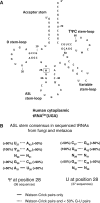Pseudouridine synthase 1: a site-specific synthase without strict sequence recognition requirements
- PMID: 22102571
- PMCID: PMC3299991
- DOI: 10.1093/nar/gkr1017
Pseudouridine synthase 1: a site-specific synthase without strict sequence recognition requirements
Abstract
Pseudouridine synthase 1 (Pus1p) is an unusual site-specific modification enzyme in that it can modify a number of positions in tRNAs and can recognize several other types of RNA. No consensus recognition sequence or structure has been identified for Pus1p. Human Pus1p was used to determine which structural or sequence elements of human tRNA(Ser) are necessary for pseudouridine (Ψ) formation at position 28 in the anticodon stem-loop (ASL). Some point mutations in the ASL stem of tRNA(Ser) had significant effects on the levels of modification and compensatory mutation, to reform the base pair, restored a wild-type level of Ψ formation. Deletion analysis showed that the tRNA(Ser) TΨC stem-loop was a determinant for modification in the ASL. A mini-substrate composed of the ASL and TΨC stem-loop exhibited significant Ψ formation at position 28 and a number of mutants were tested. Substantial base pairing in the ASL stem (3 out of 5 bp) is required, but the sequence of the TΨC loop is not required for modification. When all nucleotides in the ASL stem other than U28 were changed in a single mutant, but base pairing was retained, a near wild-type level of modification was observed.
Figures



Similar articles
-
Caenorhabditis elegans pseudouridine synthase 1 activity in vivo: tRNA is a substrate, but not U2 small nuclear RNA.Biochem J. 2003 Jun 1;372(Pt 2):595-602. doi: 10.1042/BJ20021938. Biochem J. 2003. PMID: 12597772 Free PMC article.
-
Major identity determinants for enzymatic formation of ribothymidine and pseudouridine in the T psi-loop of yeast tRNAs.J Mol Biol. 1997 Dec 12;274(4):505-18. doi: 10.1006/jmbi.1997.1417. J Mol Biol. 1997. PMID: 9417931
-
Pseudouridines and pseudouridine synthases of the ribosome.Cold Spring Harb Symp Quant Biol. 2001;66:147-59. doi: 10.1101/sqb.2001.66.147. Cold Spring Harb Symp Quant Biol. 2001. PMID: 12762017 Review.
-
Molecular recognition of tRNA by tRNA pseudouridine 55 synthase.Biochemistry. 1998 Jan 6;37(1):339-43. doi: 10.1021/bi971590p. Biochemistry. 1998. PMID: 9425055
-
The effect of pseudouridine and pH on the structure and dynamics of the anticodon stem-loop of tRNA(Lys,3).Nucleic Acids Symp Ser. 1997;(36):56-7. Nucleic Acids Symp Ser. 1997. PMID: 9478205 Review.
Cited by
-
Steroid receptor RNA activator (SRA) modification by the human pseudouridine synthase 1 (hPus1p): RNA binding, activity, and atomic model.PLoS One. 2014 Apr 10;9(4):e94610. doi: 10.1371/journal.pone.0094610. eCollection 2014. PLoS One. 2014. PMID: 24722331 Free PMC article.
-
Pseudouridine: still mysterious, but never a fake (uridine)!RNA Biol. 2014;11(12):1540-54. doi: 10.4161/15476286.2014.992278. RNA Biol. 2014. PMID: 25616362 Free PMC article. Review.
-
Schizosaccharomyces pombe pus1 mutants are temperature sensitive due to decay of tRNAIle(UAU) by the 5'-3' exonuclease Dhp1, primarily targeting the unspliced pre-tRNA.RNA. 2025 Mar 18;31(4):566-584. doi: 10.1261/rna.080315.124. RNA. 2025. PMID: 39848696 Free PMC article.
-
The role of RNA modification in hepatocellular carcinoma.Front Pharmacol. 2022 Sep 2;13:984453. doi: 10.3389/fphar.2022.984453. eCollection 2022. Front Pharmacol. 2022. PMID: 36120301 Free PMC article. Review.
-
Deciphering the epitranscriptome: A green perspective.J Integr Plant Biol. 2016 Oct;58(10):822-835. doi: 10.1111/jipb.12483. Epub 2016 Jun 20. J Integr Plant Biol. 2016. PMID: 27172004 Free PMC article. Review.
References
-
- Auffinger P, Westhof E. In: Modification and Editing of RNA. Grosjean H, Benne R, editors. Washinton, D.C.: ASM Press; 1998. pp. 569–576.
-
- Massenet SA, Mougin A, Branlant C. In: Modification and Editing of RNA. Grosjean H, Benne R, editors. Washington, D.C.: ASM Press; 1998. pp. 201–227.
-
- Ofengand J, Fournier MJ. In: Modification and Editing of RNA. Grosjean H, Benne R, editors. Washington, D.C.: ASM Press; 1998. pp. 229–253.
-
- Hamma T, Ferre-D'Amare AR. Pseudouridine synthases. Chem. Biol. 2006;13:1125–1135. - PubMed
Publication types
MeSH terms
Substances
Grants and funding
LinkOut - more resources
Full Text Sources
Molecular Biology Databases

